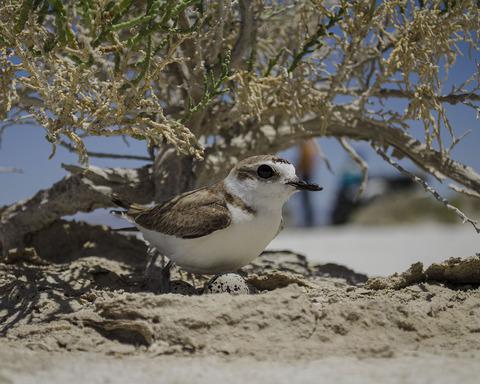当前位置:
X-MOL 学术
›
Funct. Ecol.
›
论文详情
Our official English website, www.x-mol.net, welcomes your
feedback! (Note: you will need to create a separate account there.)
The importance of functional responses among competing predators for avian nesting success
Functional Ecology ( IF 4.6 ) Pub Date : 2019-10-02 , DOI: 10.1111/1365-2435.13460 Kristen S. Ellis 1 , Randy T. Larsen 2 , David N. Koons 3
Functional Ecology ( IF 4.6 ) Pub Date : 2019-10-02 , DOI: 10.1111/1365-2435.13460 Kristen S. Ellis 1 , Randy T. Larsen 2 , David N. Koons 3
Affiliation

|
The relationship between the rate of predation and prey abundance is an important component of predator–prey dynamics. However, functional responses are less straightforward when multiple predators compete for shared prey. Interactions among competing predators can reduce or enhance effects of predation on prey populations. Because many avian populations experience high rates of nest predation, understanding the role of specific predators on nest mortality will lead to more informed conservation and management strategies which attempt to increase productivity by removing certain predators or managing habitat to limit their impact. Our goal was to evaluate effects of specific predators and the influence of nest abundance on nest mortality. We monitored snowy plover Charadrius nivosus nests across 7 years at two study areas in Utah, USA, with remote cameras. We modelled predator‐specific hazard rates for nest mortality in a Bayesian framework to assess relationships between competing predators and the role of nest abundance on predator‐specific hazard rates. We found that hazard rates for nest mortality by gulls Larus spp. decreased with increasing nest abundance, whereas nest mortality by foxes Vulpes spp. and ravens Corvus corax initially increased, indicating that dietary switching may occur when nests become more abundant. Nest mortalities of specific predators were often not independent and ranged between compensatory (e.g. mammalian mesopredators) and superadditive (e.g. avian predators) across the breeding season. The non‐independence between nest mortalities suggests that reductions in some predators may not translate to additive increases in overall nest success. Analyses of cause‐specific mortality are rarely applied to avian nests, but examination of interacting impacts among competing predators on nest survival may provide insight into specific drivers of avian population dynamics. A free Plain Language Summary can be found within the Supporting Information of this article.
中文翻译:

竞争捕食者之间功能反应对鸟类筑巢成功的重要性
捕食率和猎物丰度之间的关系是捕食者-猎物动力学的重要组成部分。然而,当多个捕食者竞争共享的猎物时,功能反应就不那么直接了。竞争捕食者之间的相互作用可以减少或增强捕食对猎物种群的影响。由于许多鸟类种群的巢穴捕食率很高,因此了解特定捕食者对巢穴死亡率的作用将导致更明智的保护和管理策略,这些策略试图通过清除某些捕食者或管理栖息地以限制其影响来提高生产力。我们的目标是评估特定捕食者的影响以及巢穴丰度对巢穴死亡率的影响。我们在美国犹他州的两个研究区对雪鸻 Charadrius nivosus 巢穴进行了 7 年的监测,带远程摄像头。我们在贝叶斯框架中对特定捕食者的巢穴死亡率进行建模,以评估竞争捕食者之间的关系以及巢穴丰度对特定捕食者危害率的作用。我们发现海鸥 Larus spp 对巢穴死亡率的危害率。随着巢丰富度的增加而降低,而狐狸 Vulpes spp. 的巢死亡率。和乌鸦 Corvus corax 最初增加,表明当巢变得更丰富时可能会发生饮食转换。特定捕食者的巢死亡率通常不是独立的,并且在整个繁殖季节介于补偿性(例如哺乳动物中食肉动物)和超加性(例如鸟类捕食者)之间。巢死亡率之间的非独立性表明,一些捕食者的减少可能不会转化为整体巢成功率的附加增加。对特定原因死亡率的分析很少应用于鸟类巢穴,但检查竞争捕食者之间对巢穴生存的相互作用影响可能会深入了解鸟类种群动态的特定驱动因素。可以在本文的支持信息中找到免费的普通语言摘要。
更新日期:2019-10-02
中文翻译:

竞争捕食者之间功能反应对鸟类筑巢成功的重要性
捕食率和猎物丰度之间的关系是捕食者-猎物动力学的重要组成部分。然而,当多个捕食者竞争共享的猎物时,功能反应就不那么直接了。竞争捕食者之间的相互作用可以减少或增强捕食对猎物种群的影响。由于许多鸟类种群的巢穴捕食率很高,因此了解特定捕食者对巢穴死亡率的作用将导致更明智的保护和管理策略,这些策略试图通过清除某些捕食者或管理栖息地以限制其影响来提高生产力。我们的目标是评估特定捕食者的影响以及巢穴丰度对巢穴死亡率的影响。我们在美国犹他州的两个研究区对雪鸻 Charadrius nivosus 巢穴进行了 7 年的监测,带远程摄像头。我们在贝叶斯框架中对特定捕食者的巢穴死亡率进行建模,以评估竞争捕食者之间的关系以及巢穴丰度对特定捕食者危害率的作用。我们发现海鸥 Larus spp 对巢穴死亡率的危害率。随着巢丰富度的增加而降低,而狐狸 Vulpes spp. 的巢死亡率。和乌鸦 Corvus corax 最初增加,表明当巢变得更丰富时可能会发生饮食转换。特定捕食者的巢死亡率通常不是独立的,并且在整个繁殖季节介于补偿性(例如哺乳动物中食肉动物)和超加性(例如鸟类捕食者)之间。巢死亡率之间的非独立性表明,一些捕食者的减少可能不会转化为整体巢成功率的附加增加。对特定原因死亡率的分析很少应用于鸟类巢穴,但检查竞争捕食者之间对巢穴生存的相互作用影响可能会深入了解鸟类种群动态的特定驱动因素。可以在本文的支持信息中找到免费的普通语言摘要。









































 京公网安备 11010802027423号
京公网安备 11010802027423号